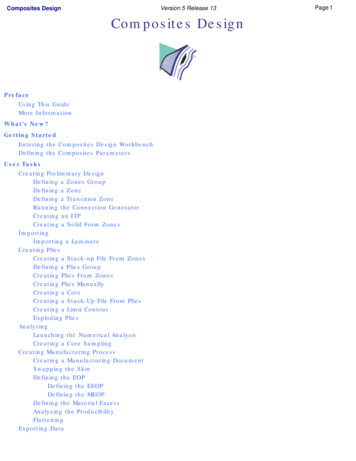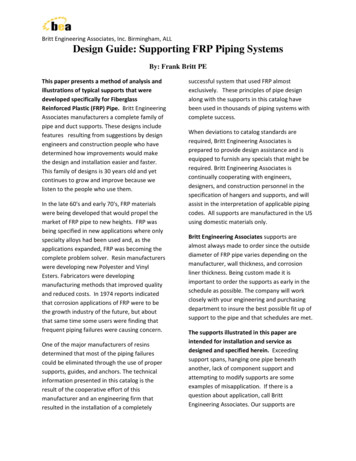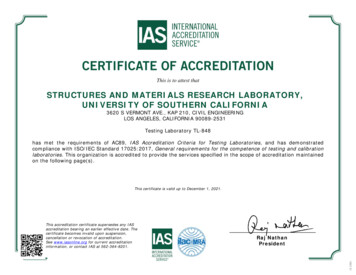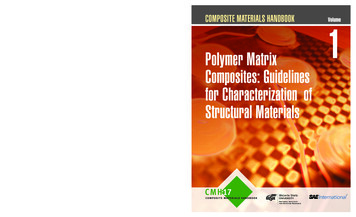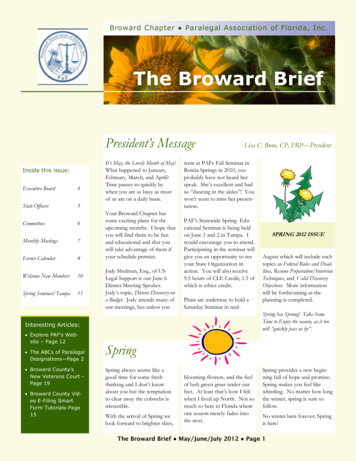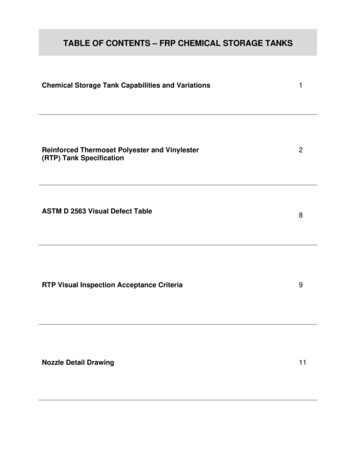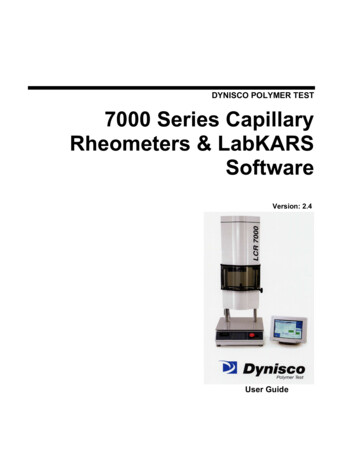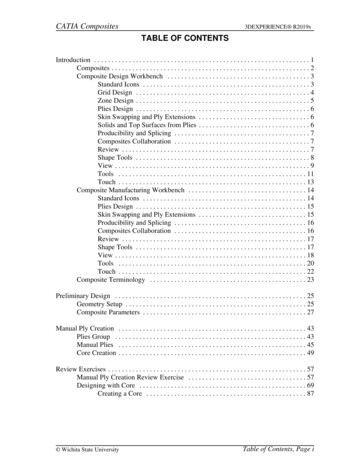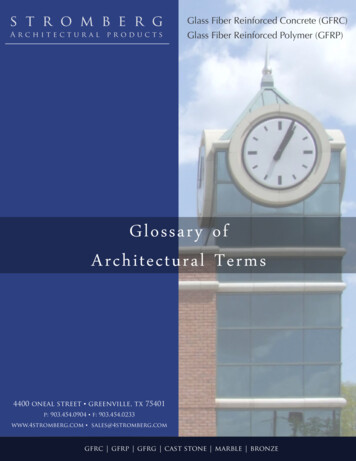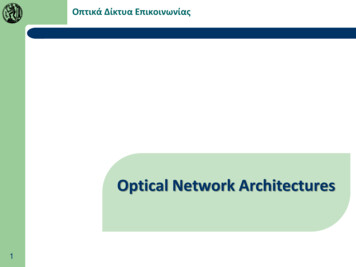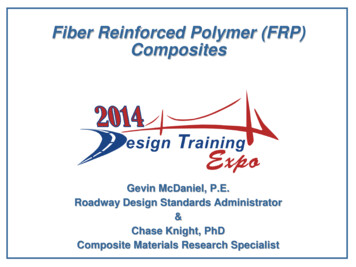
Transcription
Fiber Reinforced Polymer (FRP)CompositesGevin McDaniel, P.E.Roadway Design Standards Administrator&Chase Knight, PhDComposite Materials Research Specialist
Topics Covered Overview of FRP Composites Currently Available National Specifications FDOT Design Criteria and Specifications Acceptable FDOT Applications Research on FRP Composites District 7 Demonstration Project Chase Knight, PhD - Usage (Characteristics/Durability) Questions2
FRP Overview: What is FRP? General CompositionCarbon, Glass, Etc.Polymer3
FRP Overview: Fibers Common Fiber Types: Aramid- Extremely sensitive to environmental conditions Glass (Most Widely Used)- Subject to creep under high sustained loading- Subject to degradation in alkaline environment Carbon- Premium Cost Basalt- The future of FRP fibers?4
FRP Overview: Fibers Used in many different forms:Short FibersChopped FibersLong FibersWoven Fibers5
FRP Overview: Resins Two Categories: Thermoset Resins (most common for structural uses)- Liquid state at room temperature prior to curing- Impregnated into reinforcing fibers prior to heating- Chemical reaction occurs during heating/curing- Solid after heating/curing; Can’t be reversed/reformed Thermoplastic Resins- Solid at room temperature (recycled plastic pellets)- Heated to liquid state and pressurized to impregnatereinforcing fibers- Cooled under pressure; Can be reversed/reformed6
FRP Overview: Resins Common Thermoset Resin Types Polyester- Lowest Cost Vinyl ester- Industry Standard Polyurethane- Premium Cost Epoxy- Highest Cost- Commonly used in aerospace applications7
FRP Overview: Resins Polyesters Advantages:- Easy to use- Lowest cost of resins available Disadvantages:- Sensitive to UV degradation- Only moderate mechanical properties8
FRP Overview: Resins Vinyl esters Advantages:- Very high chemical/environmental resistance- Higher mechanical properties than polyesters Disadvantages:- Sensitive to heat- Higher cost than polyesters9
FRP Overview: Resins Polyurethanes Advantages:- Higher strength and flexibility than vinyl esters- Very high chemical/environmental resistance- Higher mechanical properties than vinyl esters Disadvantages:- Higher cost than vinyl esters (about 1.5 x)10
FRP Overview: Resins Epoxies Advantages:- High mechanical and thermal properties- High moisture resistance- Long working times available- High temperature resistance Disadvantages:- More expensive than polyurethanes- Critical mixing/Consistency- Corrosive handling11
FRP Overview: Processes Manufacturing Processes Predominate Processes- Pultrusion- Vacuum Infusion Other Processes12
FRP Overview: Processes Pultrusion Processing: Linear, continuous process Reinforcing (Roving & Mats) saturated with resin Pulled through heated die Chemical reaction occurs as it cures (Polymerization) The resin saturated reinforcements exit the die in a solidstate and in the form of the cross section of the die. Types of products produced:- Structural shapes w/ constant cross-sections- GFRP/CFRP reinforcing bars & CFRP prestressing bars13
FRP Overview: Processes Pultrusion Processing:14
FRP Overview: Processes Pultrusion Processing:Courtesy of: Creative Pultrusions, Inc.Continuous Strand Mats: Reinforcements inany direction; consistent along the length ofthe member.15
FRP Overview: Processes Pultruded hollow pilesCourtesy of: Creative Pultrusions, Inc. 16
FRP Overview: Processes Various Pultruded Structural ShapesCourtesy of: Creative Pultrusions, Inc.17
FRP Overview: Processes Pultruded GFRP/CFRP reinforcing bars and dowelsCourtesy of: Hughes Brothers, Inc.Courtesy of: Hughes Brothers, Inc.GFRP Glass FRPCFRP Carbon FRP18
FRP Overview: Processes Vacuum Infusion (VIP) Reinforcing laid dry into the mold Vacuum is pulled before resin is introduced Resin is then sucked into the laminate via distributedtubing Types of products:- Structural shapes:– Uniform cross-sections– Non-uniform cross-sections19
FRP Overview: Processes Vacuum Infusion (VIP)Benefit of VIP:Reinforcing fibers oriented inany direction at specific andtargeted locations.20
FRP Overview: Processes Variable shapeand size of VIPstructuralmembers21
FRP Overview: Processes Other Processes Bladder Molding Compression Molding Thermoplastic Extrusion Filament windingBladder Molding Wet Layup OthersWet Layup22
National Specifications LRFD DesignSpecification for FRPPultruded Structures Structural shapes Connections Prefabricated buildingproducts Symmetric and balancedglass fiber reinforcing only23
National Specifications ANSI Code of StandardPractice Pultruded FRP Structures Recommendations for: Construction ContractDocuments Fabrication Installation24
National Specifications For the design andconstruction of concretebridge decks and railingsreinforced with GFRPreinforcing bars. For GFRP bars only: Deformed or SandCoated only See additionallimitations25
National Specifications For the analysis anddesign of concrete-filledFRP tubes (CFFT) for useas structural componentsin bridges For CFFT use as: Beams Arches Columns Piles26
National Specifications ACI 440 Series: FRP Reinforcementfor Concrete Materials, Design andConstructionSpecifications ASTM is currentlybeing developed toreplace the materialsspecifications for FRPreinforcing27
FDOT Design Criteria & SpecificationsFDOT Specifications FRP Composite Structural Shapes: Current Section 973: “Structural Plastics” Revised Section 973: FRP Composite Structural Shapeso Thermoset Pultruded Structural Shapeso Thermoset Vacuum Infusion Processed (VIP)Structural Shapeso Thermoplastic Structural Shapes Unreinforced Reinforced with GFRP Bars28
FDOT Design Criteria & SpecificationsFDOT Specifications FRP Composite Reinforcing: Dev. 932: FRP Reinforcing Bar (2014) Dev. 933: FRP Strand (2014) Dev. 400, 415, 450, 105 for FRP Reinforcing (2014)The draft versions currently reference ACI 440 andmodifies it to be incompliance with the latest draft of theASTM. Will reference the new ASTM once ACI 440 isreplaced.29
FDOT Design Criteria & SpecificationsNew Materials Manual Chapter 12 Included in the July 2014 Workbook Requirements for Quality Control (QC) Programs for FRPComposite Producers Must obtain FRP Composites from a producer that iscurrently on the list of Producers with Accepted QualityControl (QC) Programs for Fiber Reinforced Polymer(FRP) Composites All FRP Composites must meet the minimumrequirements of the applicable material specifications30
FDOT Design Criteria & SpecificationsNew Structure Manual, Volume 4 Scheduled for release with the 2015 Structures Manual Guidance on acceptable uses for FRP Composites Guidance on how to incorporate FRP Components intothe Contract Documents Provides Design Guidelines and appropriate referencesto the applicable National Specifications Guidance for preparation of Specifications Package31
FRP Overview: Applications Global Applications-Marine transportation componentsArchitectural Cladding componentsAerospace transportation and weapons componentsAutomotive componentsEnergy Sector components(wind turbines)Static Structural Components(Buildings/Bridges)32
FDOT FRP Initiatives: Structural Shapes Fender System Piles, Wales, and Catwalks Composite Beams- Hillman Beam - D7 Project Concrete Reinforcing – Invitation to Innovation Reinforcing bars Pre-stressing strands External reinforcing (maintenance)33
FDOT FRP Initiatives: Fender System Piles and Wales FDOT 471 & 973 spec. New Approved Fabricators List requirements throughMM 12.1 (July 2014) Revised SDG Section 3.14 (Jan 2015) New Structure Detailing Manual Chapter 24 (Jan2015)Courtesy of: Creative Pultrusions, Inc.34
FDOT FRP Initiatives: Composite Beams Hillman Composite Beam- constructed as a composite of three materials: steel strands,concrete, and fiber reinforced polymer- materials are arranged in a manner that the materials act as whatwould traditionally be separate structural elements- District 7 (Halls River Project)35
D7 Halls River Project Demonstration Project in District 7: CR490A bridge replacement over Halls River Bridge Length 185’-10” total 5 spans @ 37’-2” Overall Bridge Width 56’-9 3/4” Hybrid Composite Beams (Hillman Beam) 11 beams @ 5’-3” 24” Prestressed concrete piles w/CFRP strands and spirals Concrete seawalls replacement using GFRP & CFRP reinforcement Phased construction Extremely aggressive environment for both superstructure &substructure36
D7 Halls River Project37
D7 Halls River Project38
FDOT FRP Initiatives: Concrete Repair (Maintenance) Extension of service life Near Surface Reinforcing- Carbon Fiber Fabric Wraps- Near Surface Reinforcing Bars39
FDOT FRP Initiatives:Fiber Reinforced Polymer (FRP)Reinforcing Bars and Strands40
FDOT FRP Initiatives: Concrete Reinforcing Reinforcing Bars (GFRP and/or CFRP)- Approach Slabs- Bridge Decks and Bridge Deck overlays- Cast-in-Place Flat Slab Superstructures- Pile Bent Caps not in direct contact with water- Pier Columns and Caps not in direct contact with water- Retaining Walls, Noise Walls, Perimeter Walls- Pedestrian/Bicycle Railings- Bulkheads- MSE Wall Panels- Wall Copings- Drainage Structures- Concrete Sheet Piles41
FDOT FRP Initiatives: Concrete Pretensioning Pre-stressing strands(CFRP)- Pre-stressed Concrete Piles (with CFRP spirals)- Pre-stressed Concrete Sheet Piles42
ResearchM.H. Ansley Structures Research Center Recent Testing on FRP Composites GFRP Reinforced Thermoplastic Piles and Wales VIP Composite Bridge Decking Pultruded Light Poles- Breakaway Pole Bases Prestressed Concrete Piles using CFCC Post Tensioned Box Girder using CFCC Mast Arm/Light Pole repair using CFRP Wraping43
Research44
Research45
Research Leading Researcher on FRPReinforcing and Prestressing Dr. Brahim Benmokrane, P. Eng., FACI,FCSCE, FIIFC, FCAE, FEIC- FRP-ACI Committee Member- Professor of Civil Engineering-Fellow ofthe Royal Society of Canada- Tier-1 Canada Research Chair inAdvanced Composite Materials for CivilStructures- NSERC/Industry Research Chair inInnovative FRP Reinforcement forConcrete Infrastructure- Director, Quebec-FQRNT ResearchCentre on Concrete Infrastructure(CRIB)46
Usage (Characteristics/Durability) Characteristics PROS-It is highly resistant to chloride ion and chemical attackIts tensile strength is greater than that of steel yet it weighs only one quarter as muchIt is transparent to magnetic fields and radar frequenciesGFRP has low electrical and thermal conductivity CONS- Due to its inelastic behavior design codes significantly reduce the allowable stresscapacity- Due to the manufacturing processes the industry is undergoing progressivestandardization- Storage and handling requirements for FRP reinforcing on the construction site can bemore restrictive due to FRP's susceptibility to damage by overexposure to UV light,improper cutting or aggressive handling.- The initial cost of the FRP reinforcing is considerably higher than traditional steelreinforcing
Usage (Characteristics/Durability) Long term durability of GFRP Materials are resistant to degradation, but over time
Usage (Characteristics/Durability) Degradation factors Moisture- Diffusion through matrix- Flow through cracks or other flaws- Transportation medium for alkali/acid/salt Alkali- Attacks silica network in glass – “etching andleaching”GangaRao et al. Reinf. concr. des. with compos. CRC Press (2007)
Usage (Characteristics/Durability) Degradation factors Acids- Hydrogen replaces alkali and other positive mobileions in glass – “leaching” Salts- Similar to acids Temperature- Affects rate of moisture absorption and chemicalreactionsGangaRao et al. Reinf. concr. des. with compos. CRC Press (2007)
Usage (Characteristics/Durability) Materials and processing Improvements made in material selection- Polyester to Vinyl Ester (less moisture absorption)- E glass to E-CR glass fibers (less leaching)Spoo, ACMA Chemical Processing Symposium (2013)
Usage (Characteristics/Durability) E glass fiber compositeGreenwood. Pultruded composites durability. Owens Corning (2001)
Usage (Characteristics/Durability) E-CR glass fiber compositeGreenwood. Pultruded composites durability. Owens Corning (2001)
Usage (Characteristics/Durability) E vs E-CR glass fiber compositesGreenwood. Pultruded composites durability. Owens Corning (2001)
Usage (Characteristics/Durability) Materials and processing Quality of finished composite affects durability- Look for minimal defects and fully cured resin
Usage (Characteristics/Durability)
Usage (Characteristics/Durability) Long term durability of GFRP Establish model(s) to accurately describe thedegradation of GFRP based on the synergistic effectsof physical and chemical aging on fibers, matrix andinterface Establish protocol for service life prediction based onthe model(s)
Usage (Characteristics/Durability) Durability of CFRP Carbon fibers are highly stable, even in aggressiveenvironmentsFibers from carbon/epoxy composite treated for2 hours in 0.05 M KOH solution at 770 F, 4200 psiIndividual fibers maintained 100% tensile strengthKnight et al. Environmental Technology 33, 639-644 (2012)
FDOT Resources Structures Design Office: A. Jordan Thomas, P.E. (FDOT Policy/Standards) Gevin McDaniel, P.E. (FDOT Policy/Standards) Sam Fallaha, P.E. (FDOT Research/Testing) Will Potter, P.E. (FDOT Research/Testing) Materials Office: Chase Knight, PhD (Materials/Durability)
Composites and Advanced Materials ExpoOctober 13-16, 2014Orange County Convention CenterOrlando, FLwww.thecamx.org
Questions?
Provides Design Guidelines and appropriate references . Extension of service life Near Surface Reinforcing - Carbon Fiber Fabric Wraps - Near Surface Reinforcing Bars 39. Fiber Reinforced Polymer (FR
